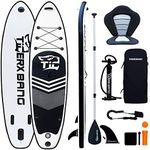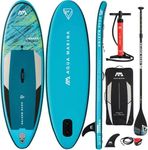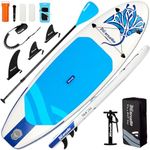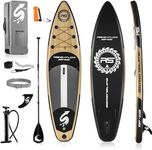Buying Guide for the Best Paddleboard For Kids
Choosing the right paddleboard for kids involves considering their safety, comfort, and ability to enjoy the water. Kids' paddleboards are designed to be more stable and easier to handle, making it important to focus on features that enhance these aspects. Understanding the key specifications will help you select a board that matches your child's size, skill level, and intended use, ensuring they have a fun and safe experience on the water.Size and VolumeSize and volume are crucial for stability and ease of use. A paddleboard's size is typically measured in length, width, and thickness, which together determine its volume. For kids, a shorter and wider board is often better as it provides more stability and is easier to maneuver. Boards around 8 to 10 feet in length are generally suitable for children. The volume should be enough to support the child's weight comfortably, ensuring the board floats well and is easy to paddle. Consider your child's weight and height when choosing the size and volume to ensure they can handle the board confidently.
Weight CapacityWeight capacity indicates the maximum weight the paddleboard can support while maintaining performance. It's important to choose a board with a weight capacity that exceeds your child's weight to ensure stability and safety. This spec is crucial because an overloaded board can become unstable and difficult to control. Look for a board with a weight capacity that comfortably accommodates your child, allowing for some growth and the possibility of carrying additional gear or a small companion.
MaterialThe material of a paddleboard affects its durability, weight, and performance. Common materials include inflatable PVC and solid epoxy. Inflatable boards are lightweight, easy to transport, and generally more forgiving for kids, making them a popular choice. Solid boards offer better performance and speed but can be heavier and more prone to damage. Consider where and how often the board will be used. If portability and ease of storage are priorities, an inflatable board might be best. For more frequent use in varied conditions, a solid board could be more suitable.
StabilityStability is a key factor for beginners and kids, as it affects their ability to balance and enjoy the paddleboarding experience. A wider board generally offers more stability, making it easier for kids to stand and paddle without tipping over. Look for boards with a width of at least 30 inches for optimal stability. If your child is new to paddleboarding, prioritize stability to help them build confidence and skills on the water.
Fin SetupThe fin setup on a paddleboard influences its tracking and maneuverability. Most kids' boards come with a single fin or a tri-fin setup. A single fin provides good tracking and is easier to maintain, while a tri-fin setup offers better maneuverability and stability in various water conditions. Consider where your child will be using the board most often. For calm waters, a single fin might suffice, but for more varied conditions, a tri-fin setup could be beneficial.
Deck PadThe deck pad is the surface on which the paddler stands, and it should provide good traction and comfort. A soft, non-slip deck pad is essential for kids to prevent slipping and ensure a comfortable experience. Look for a board with a deck pad that covers a large area, providing ample space for movement and stability. This feature is particularly important for beginners who are still developing their balance and coordination.









